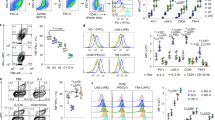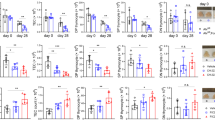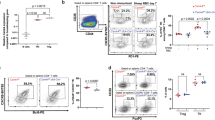Abstract
Type 1 regulatory T cells (Tr1 cells ) that produce interleukin 10 (IL-10) are instrumental in the prevention of tissue inflammation, autoimmunity and graft-versus-host disease. The transcription factor c-Maf is essential for the induction of IL-10 by Tr1 cells, but the molecular mechanisms that lead to the development of these cells remain unclear. Here we show that the ligand-activated transcription factor aryl hydrocarbon receptor (AhR), which was induced by IL-27, acted in synergy with c-Maf to promote the development of Tr1 cells. After T cell activation under Tr1-skewing conditions, the AhR bound to c-Maf and promoted transactivation of the Il10 and Il21 promoters, which resulted in the generation of Tr1 cells and the amelioration of experimental autoimmune encephalomyelitis. Manipulating AhR signaling could therefore be beneficial in the resolution of excessive inflammatory responses.
This is a preview of subscription content, access via your institution
Access options
Subscribe to this journal
Receive 12 print issues and online access
$209.00 per year
only $17.42 per issue
Buy this article
- Purchase on Springer Link
- Instant access to full article PDF
Prices may be subject to local taxes which are calculated during checkout






Similar content being viewed by others
References
Roncarolo, M.G. et al. Interleukin-10-secreting type 1 regulatory T cells in rodents and humans. Immunol. Rev. 212, 28–50 (2006).
Pflanz, S. et al. IL-27, a heterodimeric cytokine composed of EBI3 and p28 protein, induces proliferation of naive CD4+ T cells. Immunity 16, 779–790 (2002).
Villarino, A. et al. The IL-27R (WSX-1) is required to suppress T cell hyperactivity during infection. Immunity 19, 645–655 (2003).
Batten, M. et al. Interleukin 27 limits autoimmune encephalomyelitis by suppressing the development of interleukin 17-producing T cells. Nat. Immunol. 7, 929–936 (2006).
Awasthi, A. et al. A dominant function for interleukin 27 in generating interleukin 10-producing anti-inflammatory T cells. Nat. Immunol. 8, 1380–1389 (2007).
Stumhofer, J.S. et al. Interleukins 27 and 6 induce STAT3-mediated T cell production of interleukin 10. Nat. Immunol. 8, 1363–1371 (2007).
Fitzgerald, D.C. et al. Suppression of autoimmune inflammation of the central nervous system by interleukin 10 secreted by interleukin 27-stimulated T cells. Nat. Immunol. 8, 1372–1379 (2007).
Murugaiyan, G. et al. IL-27 is a key regulator of IL-10 and IL-17 production by human CD4+ T cells. J. Immunol. 183, 2435–2443 (2009).
Pot, C. et al. Cutting edge: IL-27 induces the transcription factor c-Maf, cytokine IL-21, and the costimulatory receptor ICOS that coordinately act together to promote differentiation of IL-10-producing Tr1 cells. J. Immunol. 183, 797–801 (2009).
Spolski, R., Kim, H.P., Zhu, W., Levy, D.E. & Leonard, W.J. IL-21 mediates suppressive effects via its induction of IL-10. J. Immunol. 182, 2859–2867 (2009).
Pot, C., Apetoh, L., Awasthi, A. & Kuchroo, V.K. Molecular pathways in the induction of interleukin-27-driven regulatory type 1 cells. J. Interferon Cytokine Res. 30, 381–388 (2010).
Wurster, A.L. et al. Interleukin 21 is a T helper (Th) cell 2 cytokine that specifically inhibits the differentiation of naive Th cells into interferon gamma-producing Th1 cells. J. Exp. Med. 196, 969–977 (2002).
Zhou, L. et al. IL-6 programs T(H)-17 cell differentiation by promoting sequential engagement of the IL-21 and IL-23 pathways. Nat. Immunol. 8, 967–974 (2007).
Bauquet, A.T. et al. The costimulatory molecule ICOS regulates the expression of c-Maf and IL-21 in the development of follicular T helper cells and TH-17 cells. Nat. Immunol. 10, 167–175 (2009).
Korn, T. et al. IL-21 initiates an alternative pathway to induce proinflammatory TH17 cells. Nature 448, 484–487 (2007).
Coquet, J.M., Chakravarti, S., Smyth, M.J. & Godfrey, D.I. Cutting edge: IL-21 is not essential for Th17 differentiation or experimental autoimmune encephalomyelitis. J. Immunol. 180, 7097–7101 (2008).
Xu, J. et al. c-Maf regulates IL-10 expression during Th17 polarization. J. Immunol. 182, 6226–6236 (2009).
Veldhoen, M. et al. The aryl hydrocarbon receptor links TH17-cell-mediated autoimmunity to environmental toxins. Nature 453, 106–109 (2008).
Quintana, F.J. et al. Control of Treg and TH17 cell differentiation by the aryl hydrocarbon receptor. Nature 453, 65–71 (2008).
Jones, P.B., Galeazzi, D.R., Fisher, J.M. & Whitlock, J.P. Jr. Control of cytochrome P1–450 gene expression by dioxin. Science 227, 1499–1502 (1985).
Sun, J., Madan, R., Karp, C.L. & Braciale, T.J. Effector T cells control lung inflammation during acute influenza virus infection by producing IL-10. Nat. Med. 15, 277–284 (2009).
Kerkvliet, N.I. et al. Activation of aryl hydrocarbon receptor by TCDD prevents diabetes in NOD mice and increases Foxp3 T cells in pancreatic lymph nodes. Immunotherapy 1, 539–547 (2009).
Funatake, C.J., Marshall, N.B., Steppan, L.B., Mourich, D.V. & Kerkvliet, N.I. Cutting edge: activation of the aryl hydrocarbon receptor by 2,3,7,8-tetrachlorodibenzo-p-dioxin generates a population of CD4+CD25+ cells with characteristics of regulatory T cells. J. Immunol. 175, 4184–4188 (2005).
Hibbert, L., Pflanz, S., De Waal Malefyt, R. & Kastelein, R.A. IL-27 and IFN-α signal via Stat1 and Stat3 and induce T-bet and IL-12Rβ2 in naive T cells. J. Interferon Cytokine Res. 23, 513–522 (2003).
Whitlock, J.P. Jr. Induction of cytochrome P4501A1. Annu. Rev. Pharmacol. Toxicol. 39, 103–125 (1999).
Chiaro, C.R., Morales, J.L., Prabhu, K.S. & Perdew, G.H. Leukotriene A4 metabolites are endogenous ligands for the Ah receptor. Biochemistry 47, 8445–8455 (2008).
Kim, D.W. et al. The RelA NF-κB subunit and the aryl hydrocarbon receptor (AhR) cooperate to transactivate the c-myc promoter in mammary cells. Oncogene 19, 5498–5506 (2000).
Klinge, C.M., Kaur, K. & Swanson, H.I. The aryl hydrocarbon receptor interacts with estrogen receptor alpha and orphan receptors COUP-TFI and ERRalpha1. Arch. Biochem. Biophys. 373, 163–174 (2000).
Kamanaka, M. et al. Expression of interleukin-10 in intestinal lymphocytes detected by an interleukin-10 reporter knockin tiger mouse. Immunity 25, 941–952 (2006).
Okey, A.B., Vella, L.M. & Harper, P.A. Detection and characterization of a low affinity form of cytosolic Ah receptor in livers of mice nonresponsive to induction of cytochrome P1–450 by 3-methylcholanthrene. Mol. Pharmacol. 35, 823–830 (1989).
Fitzgerald, D.C. et al. Suppressive effect of IL-27 on encephalitogenic Th17 cells and the effector phase of experimental autoimmune encephalomyelitis. J. Immunol. 179, 3268–3275 (2007).
Nicholson, L.B., Greer, J.M., Sobel, R.A., Lees, M.B. & Kuchroo, V.K. An altered peptide ligand mediates immune deviation and prevents autoimmune encephalomyelitis. Immunity 3, 397–405 (1995).
Morari, J. et al. The role of proliferator-activated receptor γ coactivator-1α in the fatty-acid-dependent transcriptional control of interleukin-10 in hepatic cells of rodents. Metabolism 59, 215–223 (2010).
Monteiro, P. et al. AhR- and c-maf-dependent induction of β7-integrin expression in human macrophages in response to environmental polycyclic aromatic hydrocarbons. Biochem. Biophys. Res. Commun. 358, 442–448 (2007).
Manel, N., Unutmaz, D. & Littman, D.R. The differentiation of human TH-17 cells requires transforming growth factor-β and induction of the nuclear receptor RORγt. Nat. Immunol. 9, 641–649 (2008).
Wolk, K., Witte, E., Witte, K., Warszawska, K. & Sabat, R. Biology of interleukin-22. Semin. Immunopathol. 32, 17–31 (2010).
Heath-Pagliuso, S. et al. Activation of the Ah receptor by tryptophan and tryptophan metabolites. Biochemistry 37, 11508–11515 (1998).
Kobayashi, S. et al. A role for the aryl hydrocarbon receptor and the dioxin TCDD in rheumatoid arthritis. Rheumatology (Oxford) 47, 1317–1322 (2008).
Kong, L.Y., Luster, M.I., Dixon, D., O'Grady, J. & Rosenthal, G.J. Inhibition of lung immunity after intratracheal instillation of benzo(a)pyrene. Am. J. Respir. Crit. Care Med. 150, 1123–1129 (1994).
Allan, L. & Sherr, D. Suppression of plasma cell differentiation by benzo[a]pyrene, an environmental pollutant. Environ Health J. 9, 15 (2010).
Camacho, I.A., Nagarkatti, M. & Nagarkatti, P.S. 2,3,7,8-Tetrachlorodibenzo-p-dioxin (TCDD) induces Fas-dependent activation-induced cell death in superantigen-primed T cells. Arch. Toxicol. 76, 570–580 (2002).
Head, J.L. & Lawrence, B.P. The aryl hydrocarbon receptor is a modulator of anti-viral immunity. Biochem. Pharmacol. 77, 642–653 (2009).
Marshall, N.B., Vorachek, W.R., Steppan, L.B., Mourich, D.V. & Kerkvliet, N.I. Functional characterization and gene expression analysis of CD4+CD25+ regulatory T cells generated in mice treated with 2,3,7,8-tetrachlorodibenzo-p-dioxin. J. Immunol. 181, 2382–2391 (2008).
Ryu, H.Y. et al. Environmental chemical-induced bone marrow B cell apoptosis: death receptor-independent activation of a caspase-3 to caspase-8 pathway. Mol. Pharmacol. 68, 1087–1096 (2005).
Schneider, D., Manzan, M.A., Yoo, B.S., Crawford, R.B. & Kaminski, N. Involvement of Blimp-1 and AP-1 dysregulation in the 2,3,7,8-tetrachlorodibenzo-p-dioxin-mediated suppression of the IgM response by B cells. Toxicol. Sci. 108, 377–388 (2009).
Singh, N.P., Nagarkatti, M. & Nagarkatti, P. Primary peripheral T cells become susceptible to 2,3,7,8-tetrachlorodibenzo-p-dioxin-mediated apoptosis in vitro upon activation and in the presence of dendritic cells. Mol. Pharmacol. 73, 1722–1735 (2008).
Gandhi, R. et al. Activation of the aryl hydrocarbon receptor induces human type 1 regulatory T cell–like and Foxp3+ regulatory T cells. Nat. Immunol. advance online publication, doi:10.1038/ni.1915 (1 August 2010).
Ho, I.C., Lo, D. & Glimcher, L.H. c-maf promotes T helper cell type 2 (Th2) and attenuates Th1 differentiation by both interleukin 4-dependent and -independent mechanisms. J. Exp. Med. 188, 1859–1866 (1998).
Schmidt, J.V., Su, G.H., Reddy, J.K., Simon, M.C. & Bradfield, C.A. Characterization of a murine Ahr null allele: involvement of the Ah receptor in hepatic growth and development. Proc. Natl. Acad. Sci. USA 93, 6731–6736 (1996).
Tone, Y. et al. Smad3 and NFAT cooperate to induce Foxp3 expression through its enhancer. Nat. Immunol. 9, 194–202 (2008).
Quintana, F.J. et al. Adaptive autoimmunity and Foxp3-based immunoregulation in zebrafish. PLoS One 5, e9478 (2010).
Acknowledgements
We thank S.C. Miaw (National Taiwan University College of Medicine) for the IL-21 reporter construct; J. Xu (Mount Sinai School of Medicine) for the IL-10 reporter construct; I-C. Ho (Brigham and Women's Hospital, Harvard Medical School) for Maf-transgenic mice; D. Littman (The Kimmel Center for Biology and Medicine of the Skirball Institute, New York University School of Medicine) for the vector overexpressing AhR-GFP; C. Karp (Cincinnati Children's Hospital Research Foundation and the University of Cincinnati College of Medicine) for IL-10–enhanced green fluorescent protein reporter mice; and D. Kozoriz for cell sorting. Supported by the US National Institutes of Health (R37NS030843, P01NS038037, P01AI056299 and P01AI039671 to V.K.K.; AI435801 and NS38037 to H.L.W.; 1K99AI075285 to F.J.Q.; and PO1-ES11624 to D.H.S.), the National Multiple Sclerosis Society (RG4111A1 to F.J.Q.), the European Molecular Biology Organization (L.A.), the Harvard Medical School Office for Diversity and Community Partnership (F.J.Q.), the Swiss National Science Foundation (N.J., and SFGBM/PASMA 118720/1 to C.P.) and the Novartis Foundation (C.P.).
Author information
Authors and Affiliations
Contributions
L.A., F.J.Q. and C.P. did in vitro and in vivo experiments and wrote the manuscript; N.J. did in vivo experiments; S.X., D.K. and E.J.B. did in vitro experiments; D.H.S. provided reagents and advice; and H.L.W. and V.K.K. supervised the study, edited the manuscript and contributed equally to this manuscript.
Corresponding authors
Ethics declarations
Competing interests
The authors declare no competing financial interests.
Supplementary information
Supplementary Text and Figures
Supplementary Figures 1–9 (PDF 2893 kb)
Rights and permissions
About this article
Cite this article
Apetoh, L., Quintana, F., Pot, C. et al. The aryl hydrocarbon receptor interacts with c-Maf to promote the differentiation of type 1 regulatory T cells induced by IL-27. Nat Immunol 11, 854–861 (2010). https://doi.org/10.1038/ni.1912
Received:
Accepted:
Published:
Issue Date:
DOI: https://doi.org/10.1038/ni.1912
This article is cited by
-
Uremic toxins mediate kidney diseases: the role of aryl hydrocarbon receptor
Cellular & Molecular Biology Letters (2024)
-
Gut microbial metabolite facilitates colorectal cancer development via ferroptosis inhibition
Nature Cell Biology (2024)
-
When AHR signaling pathways meet viral infections
Cell Communication and Signaling (2023)
-
The role of transcription factors in shaping regulatory T cell identity
Nature Reviews Immunology (2023)
-
Immune regulation through tryptophan metabolism
Experimental & Molecular Medicine (2023)



